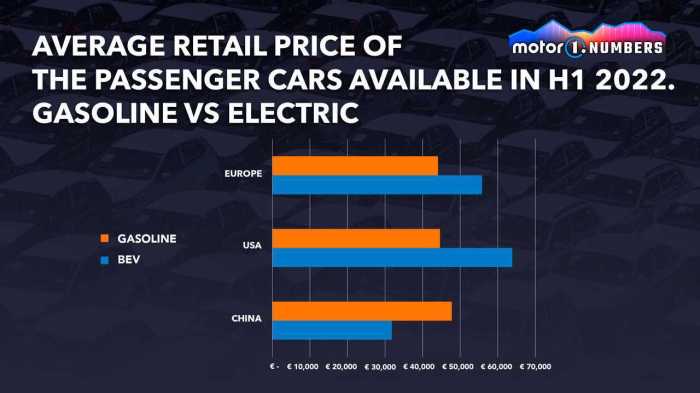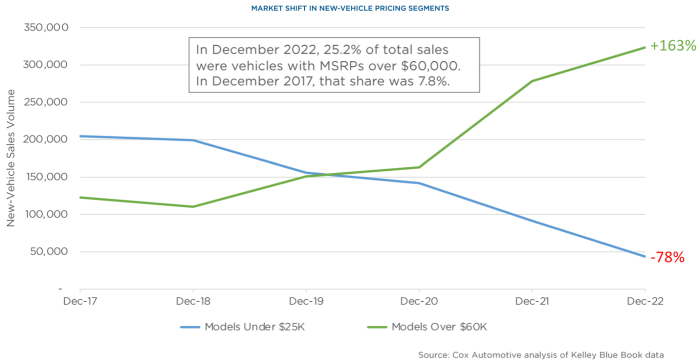New Car Price Inflation A Comprehensive Analysis
Factors Contributing to New Car Price Inflation
New car price inflation – The dramatic increase in new car prices over the past few years is a complex issue stemming from a confluence of factors. These factors, ranging from global supply chain disruptions to increased manufacturing costs, have created a perfect storm impacting affordability for consumers.
Microchip Shortages and Production

Source: motor1.com
The global microchip shortage, triggered by increased demand and pandemic-related disruptions, significantly hampered new car production. Automakers, reliant on these chips for various vehicle systems, were forced to curtail production, leading to reduced supply and increased prices for available vehicles. The limited production capacity exacerbated existing demand, pushing prices upward. This shortage disproportionately affected certain models and manufacturers, creating further price volatility.
Increased Raw Material Costs
The cost of raw materials crucial to car manufacturing, such as steel and aluminum, experienced a substantial surge. Global inflation, coupled with supply chain bottlenecks, contributed to these price hikes. This increase in input costs directly translated into higher manufacturing costs for vehicles, further driving up the final sale price.
Supply Chain Disruptions
The COVID-19 pandemic exposed vulnerabilities in global supply chains, causing significant disruptions in the delivery of parts and materials to auto manufacturers. Port congestion, shipping delays, and logistical challenges resulted in increased costs and extended production timelines. This added expense inevitably increased the final price of vehicles.
Transportation and Logistics Expenses
The cost of transporting vehicles from manufacturing plants to dealerships also increased significantly. Fuel price hikes, driver shortages, and increased shipping costs all contributed to this rise. These added logistical expenses are passed on to consumers, adding to the overall cost of a new car.
Government Regulations and Environmental Standards
Stringent government regulations aimed at improving fuel efficiency and reducing emissions have increased manufacturing costs. Meeting these standards requires investment in new technologies and manufacturing processes, which adds to the overall price of vehicles. The transition to electric vehicles, while environmentally beneficial, also presents significant upfront cost challenges.
Car Segment Price Increases (Past Five Years)
| Car Segment | 2019 Average Price (USD) | 2023 Average Price (USD) | Percentage Increase |
|---|---|---|---|
| Compact | 20,000 | 25,000 | 25% |
| SUV | 28,000 | 36,000 | 28.6% |
| Luxury | 50,000 | 65,000 | 30% |
Note: These figures are illustrative examples and may vary depending on the specific model and market conditions.
Impact of Inflation on Consumer Behavior
The surge in new car prices has profoundly impacted consumer behavior, forcing many to re-evaluate their purchasing decisions and explore alternative options.
Shift Towards Used Cars
The higher prices of new cars have led to a significant increase in demand for used vehicles. Consumers, seeking more affordable options, are turning to the used car market, driving up prices in this segment as well. This increased demand has created a competitive used car market, sometimes with prices exceeding expectations.
Rising Interest Rates and Car Loan Affordability
Increased interest rates make car loans more expensive, reducing the affordability of new vehicles for many consumers. Higher monthly payments make it difficult for potential buyers to manage their budgets, leading to a decrease in overall purchasing power. This has a particularly strong impact on those with lower incomes.
Car Financing Options in an Inflationary Environment
Consumers are now faced with a more challenging landscape of financing options. Longer loan terms may seem appealing to reduce monthly payments, but they ultimately lead to higher total interest paid over the life of the loan. This impacts the overall cost of car ownership significantly. Secured loans, while offering potentially lower interest rates, require collateral, adding another layer of complexity.
Inflation’s Effect on the Leasing Market
The leasing market has also been affected by inflation. Lease payments are influenced by the residual value of the vehicle at the end of the lease term. With new car prices increasing, the residual value is also affected, potentially leading to higher lease payments for consumers.
Inflation, Consumer Savings, and Purchasing Power
Inflation erodes the purchasing power of savings. Consumers who have saved for a new car may find that their savings are not sufficient to purchase the vehicle they desire due to the increased prices. This forces many to either postpone their purchase or reconsider their options.
Manufacturer Responses to Inflationary Pressures
Auto manufacturers are actively responding to the challenges posed by inflation through various strategic adjustments.
Production Strategy Adjustments
Manufacturers are optimizing their production strategies to mitigate the impact of supply chain disruptions and raw material price increases. This involves streamlining processes, diversifying suppliers, and exploring alternative sourcing options. Some manufacturers are also focusing on producing higher-margin vehicles to offset increased costs.
Cost-Cutting Measures
Many automakers are implementing cost-cutting measures to maintain profitability. These measures may include reducing administrative expenses, negotiating better deals with suppliers, and improving manufacturing efficiency. Some manufacturers are also reevaluating their product lines, focusing on models with higher demand and profitability.
Pricing Strategies for Profitability
Manufacturers are carefully managing their pricing strategies to balance profitability with maintaining market share. This involves a complex balancing act of adjusting prices to reflect increased costs while remaining competitive in a challenging market. Some manufacturers are opting for smaller price increases to maintain sales volume.
Impact on Research and Development
Inflationary pressures can constrain research and development (R&D) investments in the automotive industry. Companies may need to prioritize R&D projects based on their potential return on investment, potentially delaying or scaling back less critical initiatives. This could impact future technological advancements.
Marketing and Sales Strategy Adjustments
Automakers are adapting their marketing and sales strategies to address the changed consumer landscape. This includes focusing on targeted marketing campaigns, emphasizing value propositions, and offering flexible financing options to attract buyers. Some manufacturers are also investing in digital marketing to reach a wider audience.
Government Policies and New Car Prices
Government policies play a significant role in influencing new car prices, both directly and indirectly.
Potential Impact of Government Subsidies and Tax Incentives

Source: futurecdn.net
Government subsidies or tax incentives aimed at promoting fuel-efficient or electric vehicles can make new cars more affordable. These incentives can reduce the upfront cost for consumers, increasing demand and potentially stimulating production. However, the effectiveness depends on the design and implementation of such programs.
Government Regulations’ Influence on Manufacturing and Import Costs
Government regulations concerning safety, emissions, and fuel efficiency impact manufacturing costs. Stricter regulations often necessitate higher investments in technology and manufacturing processes, increasing the final price of vehicles. Import tariffs and trade agreements also influence the cost of imported vehicles.
Potential Government Interventions to Address Price Inflation
Governments could intervene to address new car price inflation through various measures. These could include addressing supply chain bottlenecks, providing financial assistance to auto manufacturers, or implementing policies to reduce raw material costs. However, the effectiveness of such interventions depends on their design and the specific market context.
Effectiveness of Past Government Policies
Past government policies related to automobile prices have had varying degrees of success. Some policies have successfully stimulated demand or improved fuel efficiency, while others have had limited impact or even unintended consequences. Careful analysis of past policies is crucial for designing effective future interventions.
Hypothetical Government Policy to Mitigate Inflation
A hypothetical policy could involve a temporary reduction in import tariffs on key components, coupled with targeted subsidies for domestic manufacturers investing in automation and supply chain diversification. This approach aims to increase supply and reduce dependence on foreign suppliers while simultaneously encouraging domestic innovation and efficiency.
Long-Term Outlook for New Car Prices
Predicting long-term trends in new car prices is challenging, but several factors suggest potential future scenarios.
Anticipated Trends Over the Next 5 Years, New car price inflation
Over the next five years, new car prices are expected to continue rising, albeit potentially at a slower pace than in recent years. This moderation depends on several factors, including the resolution of supply chain issues, stabilization of raw material costs, and the pace of technological advancements.
Factors Accelerating or Decelerating Price Increases
Factors that could accelerate price increases include persistent inflation, geopolitical instability, and further supply chain disruptions. Factors that could decelerate price increases include improved supply chain efficiency, technological advancements leading to lower production costs, and a potential shift in consumer demand.
Comparison with Historical Data
Comparing current price trends with historical data reveals that the current rate of increase is significantly higher than the average observed in previous decades. This suggests that the current inflationary pressures are exceptional and may not be representative of long-term trends.
Impact of Technological Advancements
Technological advancements, such as the widespread adoption of electric vehicles and autonomous driving systems, could influence future car prices. While these technologies may initially increase costs, they could potentially lead to lower production costs and increased efficiency in the long run.
Potential Scenarios for Future Inflation
Several scenarios are possible. A best-case scenario involves a gradual easing of inflationary pressures, leading to a slower rate of price increases. A worst-case scenario involves prolonged supply chain disruptions and continued inflation, leading to sustained high prices. A more likely scenario involves a gradual normalization of prices, with moderate increases reflecting underlying cost pressures.
FAQ: New Car Price Inflation
What are the typical financing options available during periods of high inflation?
Financing options during high inflation often include traditional auto loans (with potentially higher interest rates), leasing (which might be impacted by residual value fluctuations), and potentially longer loan terms to lower monthly payments, although this increases total interest paid.
How does inflation affect the resale value of new cars?
High inflation can initially boost the resale value of new cars due to limited supply and high demand. However, prolonged inflation can also negatively impact resale value as consumer purchasing power decreases.
Are there any alternative transportation options to consider during high new car prices?
New car price inflation is a global concern, impacting affordability worldwide. Understanding regional variations is crucial, and a good place to start is by examining the current market trends, such as those reflected in the new car price in bangladesh. This data helps illustrate how diverse factors influence the overall impact of inflation on the automotive sector.
Ultimately, these localized analyses contribute to a broader understanding of this significant economic issue.
Alternatives include used cars, public transportation, ride-sharing services, cycling, and carpooling. The feasibility of these options depends on individual circumstances and location.
How long is this new car price inflation expected to last?
Predicting the duration is challenging. It depends on resolving supply chain issues, stabilizing raw material costs, and the overall economic climate. Experts offer varied predictions, but a sustained period of elevated prices is anticipated.





















